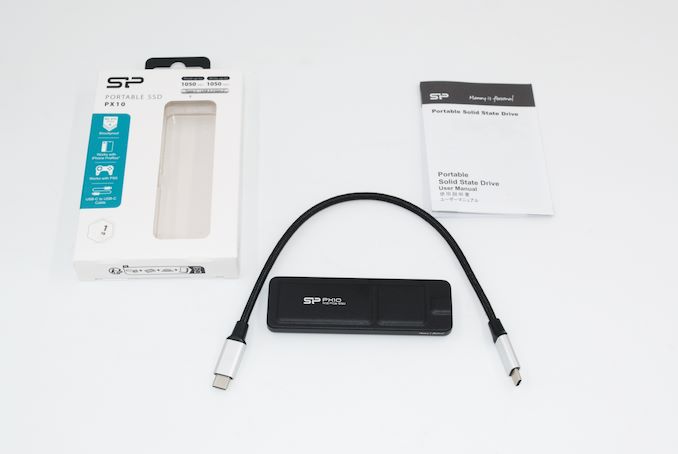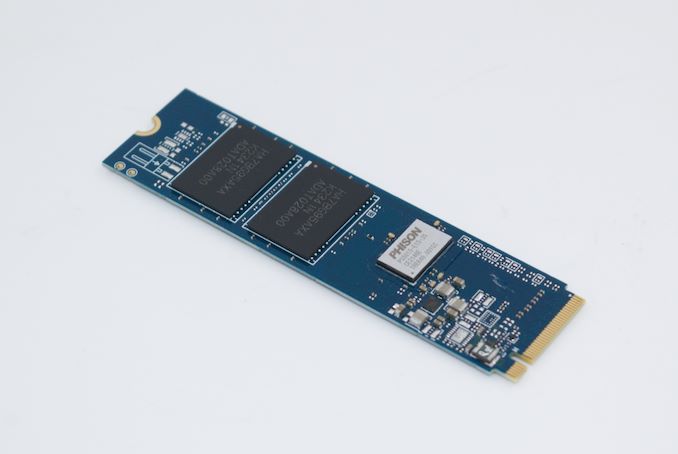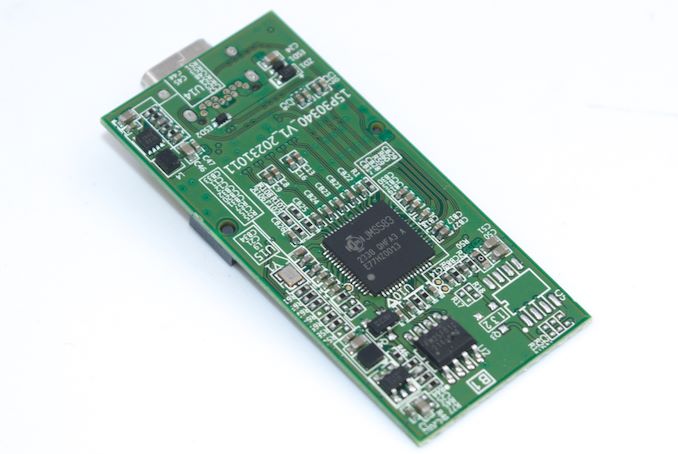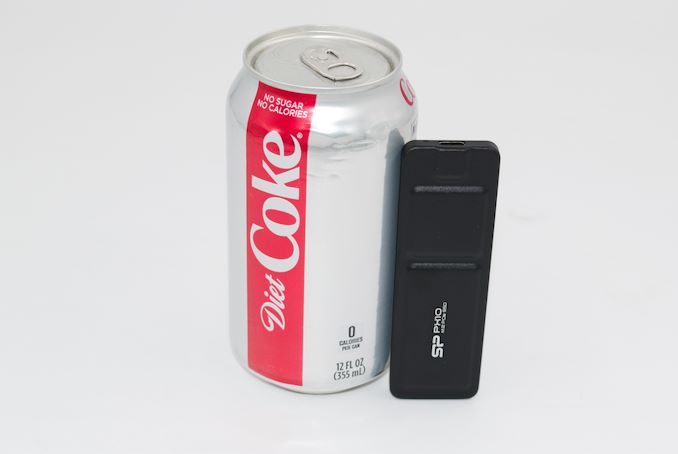
Silicon Power PX10 Portable SSD Review: One Step Forward, Two Steps Back
2024-03-04Silicon Power’s product lines have made their mark in the entry-level market with aggressive pricing. In late 2023, the company introduced a number of portable flash-based storage devices – the MS70 / DS72 thumb drives with SSD-class performance (using the Phison U17 native UFD controller), and the PX10 portable SSD in a gumstick form-factor.
The PX10 targets power users and professionals with better performance consistency compared to the thumb drives, despite all of them belonging to the 1 GBps category. Silicon Power has adopted a traditional bridge-based design for this product, placing a M.2 2280 Gen 3 x4 NVMe SSD behind a USB 3.2 Gen 2 (10 Gbps) bridge chip.
This review takes a detailed look at the internals of the PX10, followed by a discussion of the results of putting it through our rigorous direct-attached storage performance evaluation routine. Prior to discussing the value proposition, we also look at the power consumption and thermal profile of the product.
Portable SSDs have experienced significant market growth, prompting silicon vendors like Phison and Silicon Motion to create single-chip native USB flash drive (UFD) controllers. Almost all of the recent product introductions in this category have incorporated them to offer compelling performance at very attractive price points (BOM savings due to lesser number of chips on the board) while also being power efficient.
In this market situation, Silicon Power’s PX10 comes in as a bridge-based offering that is able to hit the price points of the single-chip PSSDs in the market. The form-factor of the PSSD reflects the underlying M.2 2280 NVMe SSD’s gumstick nature. Silicon Power supplies a nylon-braided 30cm USB 3.2 Gen 2 Type-C to Type-C cable in the package.
The case is held together by plastic tabs (the top part of the PX10 is aluminum, while the bottom segment is polycarbonate). It can be pried open to reveal the internals.
The case has a stylish, yet solid feel to it, with the metal top and thin nature adding to its allure. Silicon Power claims that the PX10 has a MIL-STD 810H (Method 516.8) certification, indicating shock-proofing with an element of ruggedness.
Silicon Power equips the PX10 with its P34A60 M.2 2280 Gen 3 x4 NVMe SSD. This model was launched in late 2019 with a Silicon Motion SM2263XT controller and Intel’s 64L 3D TLC. The company is now manufacturing these SSDs with Phison’s E15T controller and (likely) SK hynix’s 128L 3D TLC. Our PX10 review sample was with the Phison-based SSD.
The main board uses the JMicron JMS583 bridge chip. This was quite popular in the initial wave of NVMe SSD enclosures back in 2018, but ended up causing significant consumer grief with newer platforms from late 2019 onwards. JMicron ended up having to spin out new silicon revisions. The PX10 uses the latest and greatest A3 silicon (fourth revision), but this is still a 2018-generation product.
The PX10 supports S.M.A.R.T passthrough, as shown in the CrystalDiskInfo screenshot below.
| S.M.A.R.T Passthrough – CrystalDiskInfo | |
 |
|
The table below presents a comparative view of the specifications of the different direct-attached storage devices presented in this review.
| Comparative Direct-Attached Storage Devices Configuration | ||
| Aspect | ||
| Downstream Port | PCIe 3.0 x2 | PCIe 3.0 x2 |
| Upstream Port | USB 3.2 Gen 2 Type-C | USB 3.2 Gen 2 Type-C |
| Bridge Chip | JMicron JMS583 | ASMedia ASM2362 |
| Power | Bus Powered | Bus Powered |
| Use Case | Light-weight 1GBps-class portable SSD in a gumstick form-factor with focus on style and consistency | Light-weight 1GBps-class portable SSD with a security focus (fingerprint reader integrated) |
| Physical Dimensions | 103.4 mm x 33 mm x 10.3 mm | 85 mm x 57 mm x 8 mm |
| Weight | 33 grams | 58 grams |
| Cable | 30 cm USB 3.2 Gen 2 Type-C to Type-C | 30 cm USB 3.2 Gen 2 Type-C to Type-C 30 cm USB 3.2 Gen 2 Type-C to Type-A |
| S.M.A.R.T Passthrough | Yes | Yes |
| UASP Support | Yes | Yes |
| TRIM Passthrough | Yes | Yes |
| Hardware Encryption | No | Yes |
| Evaluated Storage | 4x 256GB HA7BG95AXA Packages (SK hynix 3D TLC?) | Samsung 92L V-NAND (5th Gen.) |
| Price | USD 90 | USD 160 |
| Review Link | Silicon Power PX10 1TB Review | Samsung Portable SSD T7 Touch 1TB Review |
Prior to looking at the benchmark numbers, power consumption, and thermal solution effectiveness, a description of the testbed setup and evaluation methodology is provided.
Testbed Setup and Evaluation Methodology
Direct-attached storage devices (including thumb drives) are evaluated using the Quartz Canyon NUC (essentially, the Xeon / ECC version of the Ghost Canyon NUC) configured with 2x 16GB DDR4-2667 ECC SODIMMs and a PCIe 3.0 x4 NVMe SSD – the IM2P33E8 1TB from ADATA.
The most attractive aspect of the Quartz Canyon NUC is the presence of two PCIe slots (electrically, x16 and x4) for add-in cards. In the absence of a discrete GPU – for which there is no need in a DAS testbed – both slots are available. In fact, we also added a spare SanDisk Extreme PRO M.2 NVMe SSD to the CPU direct-attached M.2 22110 slot in the baseboard in order to avoid DMI bottlenecks when evaluating Thunderbolt 3 devices. This still allows for two add-in cards operating at x8 (x16 electrical) and x4 (x4 electrical). Since the Quartz Canyon NUC doesn’t have a native USB 3.2 Gen 2×2 port, Silverstone’s SST-ECU06 add-in card was installed in the x4 slot. All non-Thunderbolt devices are tested using the Type-C port enabled by the SST-ECU06.
The specifications of the testbed are summarized in the table below:
| The 2021 AnandTech DAS Testbed Configuration | |
| System | Intel Quartz Canyon NUC9vXQNX |
| CPU | Intel Xeon E-2286M |
| Memory | ADATA Industrial AD4B3200716G22 32 GB (2x 16GB) DDR4-3200 ECC @ 22-22-22-52 |
| OS Drive | ADATA Industrial IM2P33E8 NVMe 1TB |
| Secondary Drive | SanDisk Extreme PRO M.2 NVMe 3D SSD 1TB |
| Add-on Card | SilverStone Tek SST-ECU06 USB 3.2 Gen 2×2 Type-C Host |
| OS | Windows 10 Enterprise x64 (21H1) |
| Thanks to ADATA, Intel, and SilverStone Tek for the build components | |
The testbed hardware is only one segment of the evaluation. Over the last few years, the typical direct-attached storage workloads for memory cards have also evolved. High bit-rate 4K videos at 60fps have become quite common, and 8K videos are starting to make an appearance. Game install sizes have also grown steadily even in portable game consoles, thanks to high resolution textures and artwork. Keeping these in mind, our evaluation scheme for portable SSDs and UFDs involves multiple workloads which are described in detail in the corresponding sections.
- Synthetic workloads using CrystalDiskMark and ATTO
- Real-world access traces using PCMark 10’s storage benchmark
- Custom robocopy workloads reflective of typical DAS usage
- Sequential write stress test
In the next section, we have an overview of the performance of the Silicon Power PX10 in these benchmarks. Prior to providing concluding remarks, we have some observations on the PSSD’s power consumption numbers and thermal solution also.
Benchmarks such as ATTO and CrystalDiskMark help provide a quick look at the performance of the direct-attached storage device. The results translate to the instantaneous performance numbers that consumers can expect for specific workloads, but do not account for changes in behavior when the unit is subject to long-term conditioning and/or thermal throttling. Yet another use of these synthetic benchmarks is the ability to gather information regarding support for specific storage device features that affect performance.
Synthetic Benchmarks – ATTO and CrystalDiskMark
Benchmarks such as ATTO and CrystalDiskMark help provide a quick look at the performance of the direct-attached storage device. The results translate to the instantaneous performance numbers that consumers can expect for specific workloads, but do not account for changes in behavior when the unit is subject to long-term conditioning and/or thermal throttling. Yet another use of these synthetic benchmarks is the ability to gather information regarding support for specific storage device features that affect performance.
Silicon Power claims read and write speeds of 1050 MBps, and these are backed up by the ATTO benchmarks provided below. ATTO benchmarking is restricted to a single configuration in terms of queue depth, and is only representative of a small sub-set of real-world workloads. It does allow the visualization of change in transfer rates as the I/O size changes, with advertised performance being reached around 256 KB for a queue depth of 4.
| ATTO Benchmarks | |
| TOP: | BOTTOM: |
 |
|
CrystalDiskMark, for example, uses four different access traces for reads and writes over a configurable region size. Two of the traces are sequential accesses, while two are 4K random accesses. Internally, CrystalDiskMark uses the Microsoft DiskSpd storage testing tool. The ‘Seq128K Q32T1’ sequential traces use 128K block size with a queue depth of 32 from a single thread, while the ‘4K Q32T16’ one does random 4K accesses with the same queue configuration, but from multiple threads. The ‘Seq1M’ traces use a 1MiB block size. The plain ‘Rnd4K’ one uses only a single queue and single thread . Comparing the ‘4K Q32T16’ and ‘4K Q1T1’ numbers can quickly tell us whether the storage device supports NCQ (native command queuing) / UASP (USB-attached SCSI protocol). If the numbers for the two access traces are in the same ballpark, NCQ / UASP is not supported. This assumes that the host port / drivers on the PC support UASP.
| CrystalDiskMark Benchmarks | |
| TOP: | BOTTOM: |
 |
|
It is clear that the PX10 supports UASP and NCQ, but the more interesting aspect is the comparative numbers against the other bridge-based PSSDs – the Samsung T7 Touch and the OWC Envoy Pro Elektron. Thanks to the use of an SSD with the latest controller and newer NAND, the random access numbers for the PX10 are class-leading, and the sequential numbers manage to match up (and saturate the bus).
AnandTech DAS Suite – Benchmarking for Performance Consistency
Our testing methodology for storage bridges / direct-attached storage units takes into consideration the usual use-case for such devices. The most common usage scenario is transfer of large amounts of photos and videos to and from the unit. Other usage scenarios include the use of the unit as a download or install location for games and importing files directly from it into a multimedia editing program such as Adobe Photoshop. Some users may even opt to boot an OS off an external storage device.
The AnandTech DAS Suite tackles the first use-case. The evaluation involves processing five different workloads:
- AV: Multimedia content with audio and video files totalling 24.03 GB over 1263 files in 109 sub-folders
- Home: Photos and document files totalling 18.86 GB over 7627 files in 382 sub-folders
- BR: Blu-ray folder structure totalling 23.09 GB over 111 files in 10 sub-folders
- ISOs: OS installation files (ISOs) totalling 28.61 GB over 4 files in one folder
- Disk-to-Disk: Addition of 223.32 GB spread over 171 files in 29 sub-folders to the above four workloads (total of 317.91 GB over 9176 files in 535 sub-folders)
Except for the ‘Disk-to-Disk’ workload, each data set is first placed in a 29GB RAM drive, and a robocopy command is issue to transfer it to the external storage unit (formatted in exFAT for flash-based units, and NTFS for HDD-based units).
robocopy /NP /MIR /NFL /J /NDL /MT:32 $SRC_PATH $DEST_PATH
Upon completion of the transfer (write test), the contents from the unit are read back into the RAM drive (read test) after a 10 second idling interval. This process is repeated three times for each workload. Read and write speeds, as well as the time taken to complete each pass are recorded. Whenever possible, the temperature of the external storage device is recorded during the idling intervals. Bandwidth for each data set is computed as the average of all three passes.
The ‘Disk-to-Disk’ workload involves a similar process, but with one iteration only. The data is copied to the external unit from the CPU-attached NVMe drive, and then copied back to the internal drive. It does include more amount of continuous data transfer in a single direction, as data that doesn’t fit in the RAM drive is also part of the workload set.

The PX10 manages to come out on top in almost all of the workload components. The few that it struggles with have a mixture of large and small-sized write accesses. That said, casual users will not notice any significant differences between the drives in the course of normal usage. However, power users may want to dig deeper to understand the limits of each device. To address this concern, we also instrumented our evaluation scheme for determining performance consistency.
Performance Consistency
Aspects influencing the performance consistency include SLC caching and thermal throttling / firmware caps on access rates to avoid overheating. This is important for power users, as the last thing that they want to see when copying over 100s of GB of data is the transfer rate going down to USB 2.0 speeds.
In addition to tracking the instantaneous read and write speeds of the DAS when processing the AnandTech DAS Suite, the temperature of the drive was also recorded. In earlier reviews, we used to track the temperature all through. However, we have observed that SMART read-outs for the temperature in NVMe SSDs using USB 3.2 Gen 2 bridge chips end up negatively affecting the actual transfer rates. To avoid this problem, we have restricted ourselves to recording the temperature only during the idling intervals. The graphs below present the recorded data.
| AnandTech DAS Suite – Performance Consistency | |
| TOP: | BOTTOM: |
 |
|
The first three sets of writes and reads correspond to the AV suite. A small gap (for the transfer of the video suite from the internal SSD to the RAM drive) is followed by three sets for the Home suite. Another small RAM-drive transfer gap is followed by three sets for the Blu-ray folder. This is followed up with the large-sized ISO files set. Finally, we have the single disk-to-disk transfer set. Silicon Power’s performance consistency claims stand verified based on the above graphs. The drive doesn’t seem to run out of SLC cache, and the drop down towards the end of the disk-to-disk set seems to have more to do with the mixture of file sizes rather than the SLC cache itself. The PX10 completed the full performance consistency test in the shortest time among all the considered PSSDs. Temperature is the only concern, as the PX10 reported 70C+ towards the end of the test.
PCMark 10 Storage Bench – Real-World Access Traces
There are a number of storage benchmarks that can subject a device to artificial access traces by varying the mix of reads and writes, the access block sizes, and the queue depth / number of outstanding data requests. We saw results from two popular ones – ATTO, and CrystalDiskMark – in a previous section. More serious benchmarks, however, actually replicate access traces from real-world workloads to determine the suitability of a particular device for a particular workload. Real-world access traces may be used for simulating the behavior of computing activities that are limited by storage performance. Examples include booting an operating system or loading a particular game from the disk.
PCMark 10’s storage bench (introduced in v2.1.2153) includes four storage benchmarks that use relevant real-world traces from popular applications and common tasks to fully test the performance of the latest modern drives:
- The Full System Drive Benchmark uses a wide-ranging set of real-world traces from popular applications and common tasks to fully test the performance of the fastest modern drives. It involves a total of 204 GB of write traffic.
- The Quick System Drive Benchmark is a shorter test with a smaller set of less demanding real-world traces. It subjects the device to 23 GB of writes.
- The Data Drive Benchmark is designed to test drives that are used for storing files rather than applications. These typically include NAS drives, USB sticks, memory cards, and other external storage devices. The device is subjected to 15 GB of writes.
- The Drive Performance Consistency Test is a long-running and extremely demanding test with a heavy, continuous load for expert users. In-depth reporting shows how the performance of the drive varies under different conditions. This writes more than 23 TB of data to the drive.
Despite the data drive benchmark appearing most suitable for testing direct-attached storage, we opt to run the full system drive benchmark as part of our evaluation flow. Many of us use portable flash drives as boot drives and storage for Steam games. These types of use-cases are addressed only in the full system drive benchmark.
The Full System Drive Benchmark comprises of 23 different traces. For the purpose of presenting results, we classify them under five different categories:
- Boot: Replay of storage access trace recorded while booting Windows 10
- Creative: Replay of storage access traces recorded during the start up and usage of Adobe applications such as Acrobat, After Effects, Illustrator, Premiere Pro, Lightroom, and Photoshop.
- Office: Replay of storage access traces recorded during the usage of Microsoft Office applications such as Excel and Powerpoint.
- Gaming: Replay of storage access traces recorded during the start up of games such as Battlefield V, Call of Duty Black Ops 4, and Overwatch.
- File Transfers: Replay of storage access traces (Write-Only, Read-Write, and Read-Only) recorded during the transfer of data such as ISOs and photographs.
PCMark 10 also generates an overall score, bandwidth, and average latency number for quick comparison of different drives. The sub-sections in the rest of the page reference the access traces specified in the PCMark 10 Technical Guide.
Booting Windows 10
The read-write bandwidth recorded for each drive in the boo (that is the tag given in the official PCMark technical guide) access trace is presented below.

Bridge-based PSSDs tend to perform better than native UFD-based ones for OS workloads like booting which involve large number of random small-sized accesses. The PX10 and the T7 Touch take up the top two spots.
Creative Workloads
The read-write bandwidth recorded for each drive in the sacr, saft, sill, spre, slig, sps, aft, exc, ill, ind, psh, and psl access traces are presented below.
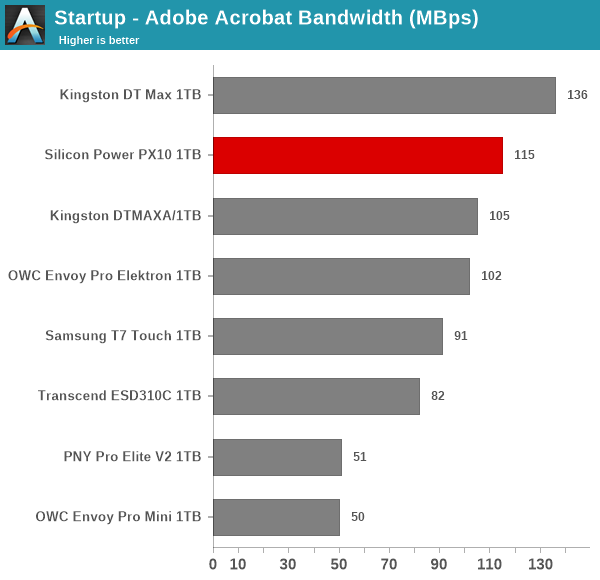
The PX10 manages to come out on top in almost all of the creative workload components. It is not far off the top even in the ones in which it slips to the second or third place.
Office Workloads
The read-write bandwidth recorded for each drive in the exc and pow access traces are presented below.
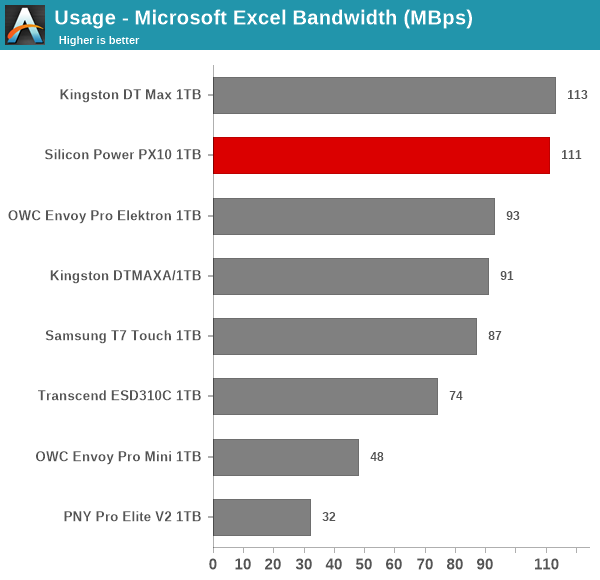
Performance with spreadsheets is excellent, but the sequence of accesses for presentations appears to trip up the PX10.
Gaming Workloads
The read-write bandwidth recorded for each drive in the bf, cod, and ow access traces are presented below.

As a general purpose PSSD, the PX10 doesn’t appear to be optimized for reads like the others in the list. As a result, gaming workloads see the PX10 in the middle of the pack.
Files Transfer Workloads
The read-write bandwidth recorded for each drive in the cp1, cp2, cp3, cps1, cps2, and cps3 access traces are presented below.
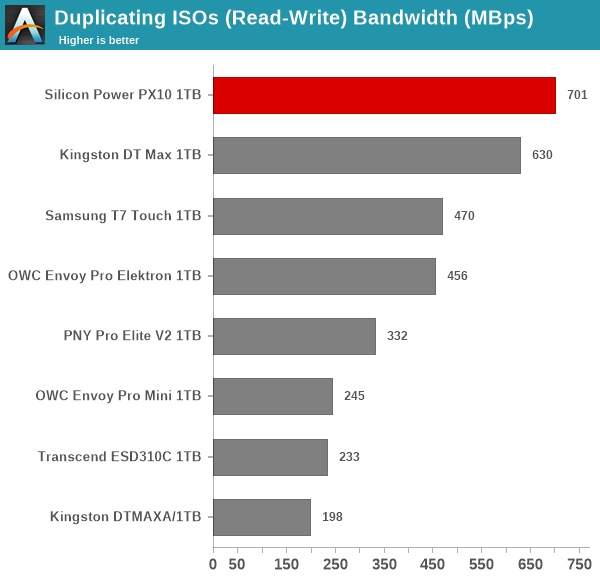
These workload components reflect what we already saw in the AnandTech DAS Suite, with the PX10 making almost a clean sweep of the top spot for the different components.
Overall Scores
PCMark 10 reports an overall score based on the observed bandwidth and access times for the full workload set. The score, bandwidth, and average access latency for each of the drives are presented below.

The trip-up in the gaming workload pushes down the PX10 to the second spot in the overall scores, but it is still within touching distance of the DT Max (which actually performs quite badly in the performance consistency test).
The performance of the portable SSDs in various real-world access traces as well as synthetic workloads was brought out in the preceding sections. We also looked at the performance consistency for these cases. Power users may also be interested in performance consistency under worst-case conditions, as well as drive power consumption. The latter is also important when used with battery powered devices such as notebooks and smartphones. Pricing is also an important aspect. We analyze each of these in detail below.
Worst-Case Performance Consistency
Flash-based storage devices tend to slow down in unpredictable ways when subject to a large number of small-sized random writes. Many benchmarks use that scheme to pre-condition devices prior to the actual testing in order to get a worst-case representative number. Fortunately, such workloads are uncommon for direct-attached storage devices, where workloads are largely sequential in nature. Use of SLC caching as well as firmware caps to prevent overheating may cause drop in write speeds when a flash-based DAS device is subject to sustained sequential writes.
Our Sequential Writes Performance Consistency Test configures the device as a raw physical disk (after deleting configured volumes). A fio workload is set up to write sequential data to the raw drive with a block size of 128K and iodepth of 32 to cover 90% of the drive capacity. The internal temperature is recorded at either end of the workload, while the instantaneous write data rate and cumulative total write data amount are recorded at 1-second intervals.
| Sequential Writes to 90% Capacity – Performance Consistency | |
| TOP: | BOTTOM: |
 |
|
The PX10 can write at 1 GBps+ for around 10 seconds pointing to a 11 GB cache, but the speed remains around 850 MBps for the next 15 minutes. After 768 GB of sustained writes, there is a slight hiccup (the drive stutters a bit at less than 100 MBps for 5 to 10 seconds a couple of times) before getting back to the 850 MBps level. This hiccup is likely due to thermal throttling, as the temperature reported at the end was 75C (and is likely to have been higher at earlier points in the write process).
Power Consumption
Bus-powered devices can configure themselves to operate within the power delivery constraints of the host port. While Thunderbolt ports are guaranteed to supply up to 15W for client devices, USB 2.0 ports are guaranteed to deliver only 2.5W (500mA @ 5V). In this context, it is interesting to have a fine-grained look at the power consumption profile of the various external drives. Using the ChargerLAB KM003C, the bus power consumption of the drives was tracked while processing the CrystalDiskMark workloads (separated by 5s intervals). The graphs below plot the instantaneous bus power consumption against time, while singling out the maximum and minimum power consumption numbers.
| CrystalDiskMark Workloads – Power Consumption | |
| TOP: | BOTTOM: |
 |
|
The PX10 has a peak power consumption of 4.35 W and a minimum consumption of 1.21 W. There seems to be no ‘deep sleep’ mode. The PX10 cuts a sorry figure in terms of power efficiency compared to the other products in the comparison list.
Final Words
The Silicon Power PX10 is currently available in three capacities – $90 for 1 TB, $140 for 2 TB, and $220 for the 4 TB version. These are aggressive price points that match / better the ones based on native UFD controllers (such as the PNY Pro Elite V2).
Based on the evaluation of different portable SSDs and the current pricing, it is clear that the performance and the value proposition (performance per dollar) for the Silicon Power PX10 is very compelling. The PX10 scores well on the consistency front too. Our main cause for concern is the use of an outdated JMicron JMS583 bridge chip resulting in disappointing power consumption numbers. An additional effect is the requirement for a better thermal solution. The metal top succeeds in dissipating some of the heat. The polycarbonate underside, despite the affixing of a thermal pad, doesn’t appear to help much. As a result, the drive does seem to thermally throttle – the saving grace for the PX10 is that its competition suffers from performance loss due to running out of the SLC cache much earlier in the stress routine.
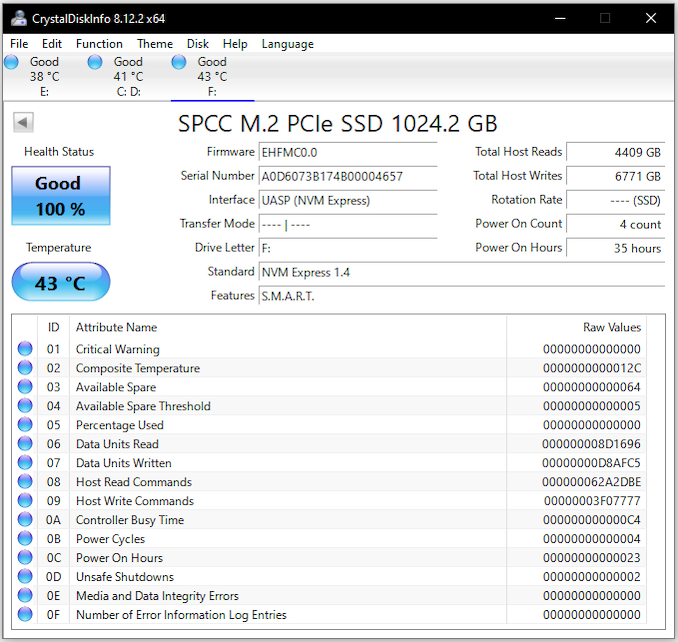
6 TB+ writes and 4 TB+ reads at the end of our testing routine
The Silicon Power PX10 presents an excellent value proposition. At its price point, it is easy to look past the power efficiency and thermal profile issues. A more judicious choice of a bridge chip and better focus on the internal SSD power consumption profile could have made the PX10 an even more compelling choice than what it is in its current avatar.
